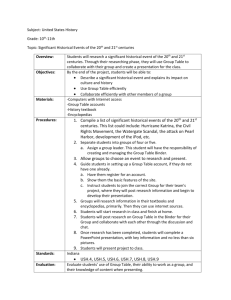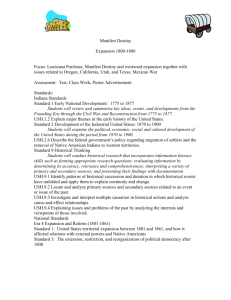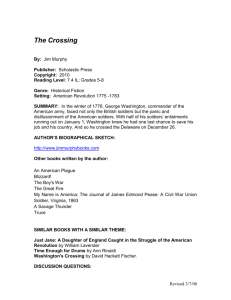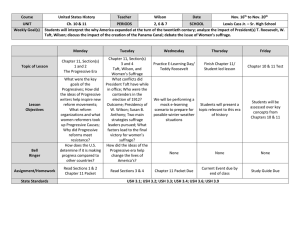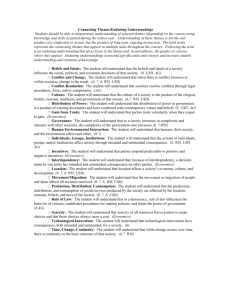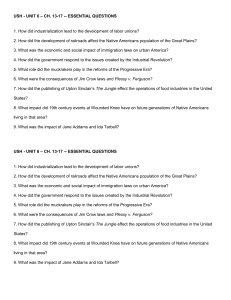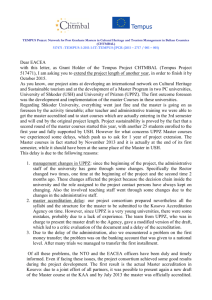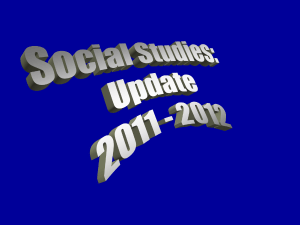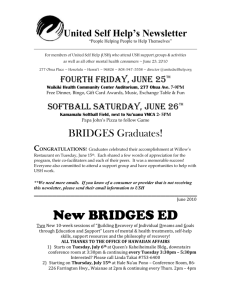Scope and Sequence - HISD Curriculum 2011-2012
advertisement
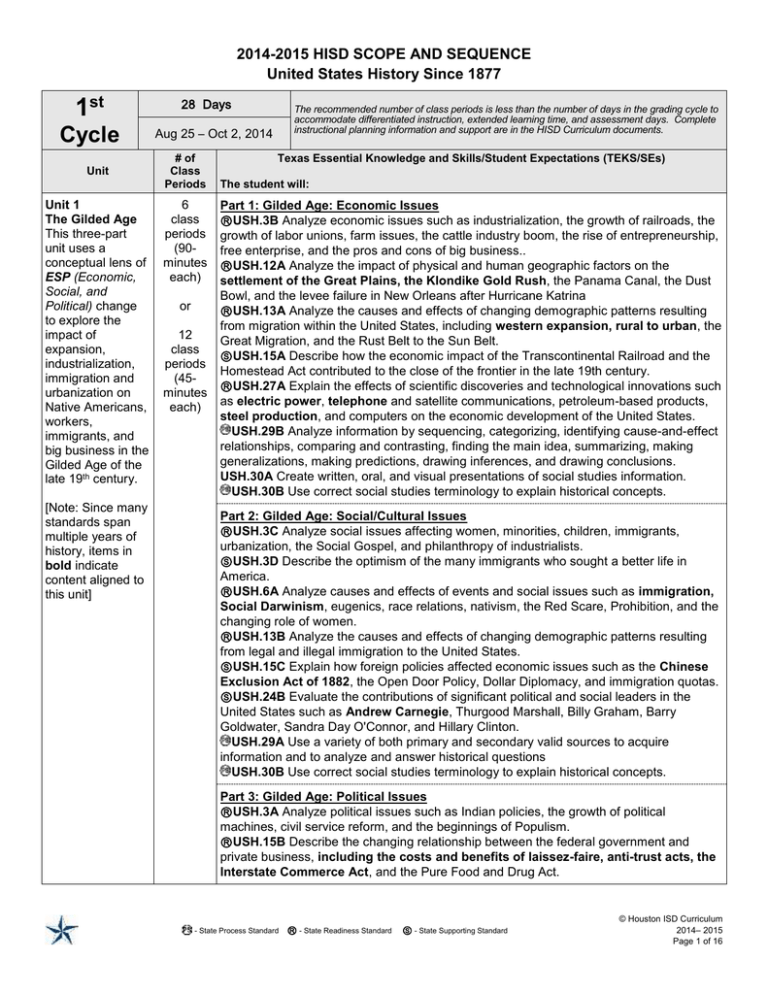
2014-2015 HISD SCOPE AND SEQUENCE United States History Since 1877 1st Cycle Unit Unit 1 The Gilded Age This three-part unit uses a conceptual lens of ESP (Economic, Social, and Political) change to explore the impact of expansion, industrialization, immigration and urbanization on Native Americans, workers, immigrants, and big business in the Gilded Age of the late 19th century. [Note: Since many standards span multiple years of history, items in bold indicate content aligned to this unit] 28 Days The recommended number of class periods is less than the number of days in the grading cycle to accommodate differentiated instruction, extended learning time, and assessment days. Complete instructional planning information and support are in the HISD Curriculum documents. Aug 25 – Oct 2, 2014 # of Class Periods 6 class periods (90minutes each) or 12 class periods (45minutes each) Texas Essential Knowledge and Skills/Student Expectations (TEKS/SEs) The student will: Part 1: Gilded Age: Economic Issues ⓇUSH.3B Analyze economic issues such as industrialization, the growth of railroads, the growth of labor unions, farm issues, the cattle industry boom, the rise of entrepreneurship, free enterprise, and the pros and cons of big business.. ⓇUSH.12A Analyze the impact of physical and human geographic factors on the settlement of the Great Plains, the Klondike Gold Rush, the Panama Canal, the Dust Bowl, and the levee failure in New Orleans after Hurricane Katrina ⓇUSH.13A Analyze the causes and effects of changing demographic patterns resulting from migration within the United States, including western expansion, rural to urban, the Great Migration, and the Rust Belt to the Sun Belt. ⓈUSH.15A Describe how the economic impact of the Transcontinental Railroad and the Homestead Act contributed to the close of the frontier in the late 19th century. ⓇUSH.27A Explain the effects of scientific discoveries and technological innovations such as electric power, telephone and satellite communications, petroleum-based products, steel production, and computers on the economic development of the United States. USH.29B Analyze information by sequencing, categorizing, identifying cause-and-effect relationships, comparing and contrasting, finding the main idea, summarizing, making generalizations, making predictions, drawing inferences, and drawing conclusions. USH.30A Create written, oral, and visual presentations of social studies information. USH.30B Use correct social studies terminology to explain historical concepts. Part 2: Gilded Age: Social/Cultural Issues ⓇUSH.3C Analyze social issues affecting women, minorities, children, immigrants, urbanization, the Social Gospel, and philanthropy of industrialists. ⓈUSH.3D Describe the optimism of the many immigrants who sought a better life in America. ⓇUSH.6A Analyze causes and effects of events and social issues such as immigration, Social Darwinism, eugenics, race relations, nativism, the Red Scare, Prohibition, and the changing role of women. ⓇUSH.13B Analyze the causes and effects of changing demographic patterns resulting from legal and illegal immigration to the United States. ⓈUSH.15C Explain how foreign policies affected economic issues such as the Chinese Exclusion Act of 1882, the Open Door Policy, Dollar Diplomacy, and immigration quotas. ⓈUSH.24B Evaluate the contributions of significant political and social leaders in the United States such as Andrew Carnegie, Thurgood Marshall, Billy Graham, Barry Goldwater, Sandra Day O'Connor, and Hillary Clinton. USH.29A Use a variety of both primary and secondary valid sources to acquire information and to analyze and answer historical questions USH.30B Use correct social studies terminology to explain historical concepts. Part 3: Gilded Age: Political Issues ⓇUSH.3A Analyze political issues such as Indian policies, the growth of political machines, civil service reform, and the beginnings of Populism. ⓇUSH.15B Describe the changing relationship between the federal government and private business, including the costs and benefits of laissez-faire, anti-trust acts, the Interstate Commerce Act, and the Pure Food and Drug Act. - State Process Standard Ⓡ - State Readiness Standard Ⓢ - State Supporting Standard © Houston ISD Curriculum 2014– 2015 Page 1 of 16 2014-2015 HISD SCOPE AND SEQUENCE United States History Since 1877 1st Cycle Unit 28 Days The recommended number of class periods is less than the number of days in the grading cycle to accommodate differentiated instruction, extended learning time, and assessment days. Complete instructional planning information and support are in the HISD Curriculum documents. Aug 25 – Oct 2, 2014 # of Class Periods Texas Essential Knowledge and Skills/Student Expectations (TEKS/SEs) The student will: USH.29A Use a variety of both primary and secondary valid sources to acquire information and to analyze and answer historical questions USH.29B Analyze information by sequencing, categorizing, identifying cause-and-effect relationships, comparing and contrasting, finding the main idea, summarizing, making generalizations, making predictions, drawing inferences, and drawing conclusions. USH.30B Use correct social studies terminology to explain historical concepts. Unit 2 Age of Imperialism and Reform This two-part unit examines the concepts of reform and imperialism. D Within the U.S., reformers made efforts to correct economic and social abuses of the Gilded Age In the early 20th century the U.S. entered a new historical era of expansionism beyond its natural borders. U.S. imperialism led to involvement in the Spanish-American War, changing policies in Latin America and Asia and eventually to World War I. 5 class periods (90minutes each) or 10 class periods (45minutes each) Part 1: Reform: Populism/Progressivism ⓇUSH.5A Evaluate the impact of Progressive Era reforms, including initiative, referendum, recall, and the passage of the 16th, 17th, 18th, and 19th amendments. ⓈUSH.5B Evaluate the impact of muckrakers and reform leaders such as Upton Sinclair, Susan B. Anthony, Ida B. Wells, and W. E. B. DuBois on American society. ⓈUSH.5C Evaluate the impact of third parties, including the Populist and Progressive parties. ⓈUSH.14B Identify the roles of governmental entities and private citizens in managing the environment such as the establishment of the National Park System, the Environmental Protection Agency (EPA), and the Endangered Species Act. ⓇUSH.15B Describe the changing relationship between the federal government and private business, including the costs and benefits of laissez-faire, anti-trust acts, the Interstate Commerce Act, and the Pure Food and Drug Act. ⓈUSH.15E Describe the emergence of monetary policy in the United States, including the Federal Reserve Act of 1913 and the shifting trend from a gold standard to fiat money. ⓈUSH.26D Identify the political, social, and economic contributions of women such as Frances Willard, Jane Addams, Eleanor Roosevelt, Dolores Huerta, Sonia Sotomayor, and Oprah Winfrey to American society. USH.29A Use a variety of both primary and secondary valid sources to acquire information and to analyze and answer historical questions USH.29B Analyze information by sequencing, categorizing, identifying cause-and-effect relationships, comparing and contrasting, finding the main idea, summarizing, making generalizations, making predictions, drawing inferences, and drawing conclusions. USH.30B Use correct social studies terminology to explain historical concepts. Part 2: 2 Lessons: Foreign Policy: Expanding U.S. Influence ⓇUSH.4A Explain why significant events, policies, and individuals such as the SpanishAmerican War, U.S. expansionism, Henry Cabot Lodge, Alfred Thayer Mahan, Theodore Roosevelt, Sanford B. Dole, and missionaries moved the United States into the position of a world power. ⓈUSH.4B Evaluate American expansionism, including acquisitions such as Guam, Hawaii, the Philippines, and Puerto Rico ⓇUSH.12A Analyze the impact of physical and human geographic factors on the settlement of the Great Plains, the Klondike Gold Rush, the Panama Canal, the Dust Bowl, and the levee failure in New Orleans after Hurricane Katrina. ⓈUSH.12B Identify and explain reasons for changes in political boundaries such as those resulting from statehood and international conflicts. ⓈUSH.15C Explain how foreign policies affected economic issues such as the Chinese Exclusion Act of 1882, the Open Door Policy, Dollar Diplomacy, and immigration quotas. - State Process Standard Ⓡ - State Readiness Standard Ⓢ - State Supporting Standard © Houston ISD Curriculum 2014– 2015 Page 2 of 16 2014-2015 HISD SCOPE AND SEQUENCE United States History Since 1877 1st Cycle Unit 28 Days The recommended number of class periods is less than the number of days in the grading cycle to accommodate differentiated instruction, extended learning time, and assessment days. Complete instructional planning information and support are in the HISD Curriculum documents. Aug 25 – Oct 2, 2014 # of Class Periods Texas Essential Knowledge and Skills/Student Expectations (TEKS/SEs) The student will: ⓇUSH.15D Describe the economic effects of international military conflicts, including the Spanish-American War and World War I, on the United States. USH.29F Identify bias in written, oral, and visual material. USH.29H Use appropriate skills to analyze and interpret social studies information such as maps, graphs, presentations, speeches, lectures, and political cartoons. USH.30B Use correct social studies terminology to explain historical concepts. - State Process Standard Ⓡ - State Readiness Standard Ⓢ - State Supporting Standard © Houston ISD Curriculum 2014– 2015 Page 3 of 16 2014-2015 HISD SCOPE AND SEQUENCE United States History Since 1877 2nd Cycle Unit Unit 3 World War I and Social Change in the 1920s This four-part unit examines the global conflict of World War I and its effects as well as the significant social change of the 1920s as Americans became more isolationists and responded to significant change in social norms, consumerism, technological advances and artistic achievement. 25 Days The recommended number of lessons is less than the number of days in the grading cycle to accommodate differentiated instruction, extended learning time, and assessment days. Complete instructional planning information and support are in the HISD Curriculum documents. Oct 6 – Nov 7, 2014 # of Class Periods 5 class periods (90minutes each) or 10 class periods (45minutes each) Texas Essential Knowledge and Skills/Student Expectations (TEKS/SEs) The student will: Part 1: World War I – Causes, Events of War, Effects ⓇUSH.4C Identify the causes of World War I and reasons for U.S. entry. ⓈUSH.4D Understand the contributions of the American Expeditionary Forces (AEF) led by General John J. Pershing. ⓈUSH.4G Analyze significant events such as the Battle of Argonne Forest. ⓈUSH.4E Analyze the impact of significant technological innovations in World War I such as machine guns, airplanes, tanks, poison gas, and trench warfare that resulted in the stalemate on the Western Front. ⓇUSH.4F Analyze major issues such as isolationism and neutrality raised by U.S. involvement in World War I, Woodrow Wilson's Fourteen Points, and the Treaty of Versailles. ⓇUSH.15D Describe the economic effects of international military conflicts, including the Spanish-American War and World War I, on the United States. ⓈUSH.26F Discuss the importance of Congressional Medal of Honor recipients, including individuals of all races and genders such as Vernon J. Baker, Alvin York, and Roy Benavidez. USH.29A Use a variety of both primary and secondary valid sources to acquire information and to analyze and answer historical questions USH.29B Analyze information by sequencing, categorizing, identifying cause-and-effect relationships, comparing and contrasting, finding the main idea, summarizing, making generalizations, making predictions, drawing inferences, and drawing conclusions. USH.29H Use appropriate skills to analyze and interpret social studies information such as maps, graphs, presentations, speeches, lectures, and political cartoons. USH.30B Use correct social studies terminology to explain historical concepts. Part 2: Social/Cultural and Technological Change in the 1920s ⓇUSH.6A Analyze causes and effects of events and social issues such as immigration, Social Darwinism, eugenics, race relations, nativism, the Red Scare, Prohibition, and the changing role of women. ⓈUSH.6B Analyze the impact of significant individuals such as Clarence Darrow, William Jennings Bryan, Henry Ford, Glenn Curtiss, Marcus Garvey, and Charles A. Lindbergh. ⓇUSH.13A Analyze the causes and effects of changing demographic patterns resulting from migration within the United States, including western expansion, rural to urban, the Great Migration, and the Rust Belt to the Sun Belt. ⓈUSH.25A Describe how the characteristics and issues in U.S. history have been reflected in various genres of art, music, film, and literature. ⓇUSH.25B Describe both the positive and negative impacts of significant examples of cultural movements in art, music, and country and western music on American society. ⓇUSH.26C Explain how the contributions of people of various racial, ethnic, gender, and religious groups shape American culture. ⓇUSH.27C Understand the impact of technological and management innovations and their applications in the workplace and the resulting productivity enhancements for business and labor such as assembly line manufacturing, time-study analysis, robotics, computer management, and just-in-time inventory management. USH.29A Use a variety of both primary and secondary valid sources to acquire information and to analyze and answer historical questions - State Process Standard Ⓡ - State Readiness Standard Ⓢ - State Supporting Standard © Houston ISD Curriculum 2014– 2015 Page 4 of 16 2014-2015 HISD SCOPE AND SEQUENCE United States History Since 1877 2nd Cycle Unit 25 Days The recommended number of lessons is less than the number of days in the grading cycle to accommodate differentiated instruction, extended learning time, and assessment days. Complete instructional planning information and support are in the HISD Curriculum documents. Oct 6 – Nov 7, 2014 # of Class Periods Texas Essential Knowledge and Skills/Student Expectations (TEKS/SEs) The student will: USH.29B Analyze information by sequencing, categorizing, identifying cause-and-effect relationships, comparing and contrasting, finding the main idea, summarizing, making generalizations, making predictions, drawing inferences, and drawing conclusions. USH.29G Identify and support with historical evidence a point of view on a social studies issue or event. USH.30B Use correct social studies terminology to explain historical concepts. Unit 4 Economics and Politics of the 1920s and 1930s In this two-part unit students study the 1920s and 1930s through an economic and political lens, as Americans addressed the prosperity of the 1920s followed by severe depression of the 1930s. 5 class periods (90minutes each) or 10 class periods (45minutes each) Part 1: Prosperity [Economics] and Politics of the 1920s ⓇUSH.6A Analyze causes and effects of events and social issues such as immigration, Social Darwinism, eugenics, race relations, nativism, the Red Scare, Prohibition, and the changing role of women. ⓈUSH.15C Explain how foreign policies affected economic issues such as the Chinese Exclusion Act of 1882, the Open Door Policy, Dollar Diplomacy, and immigration quotas. ⓈUSH.16A Analyze causes of economic growth and prosperity in the 1920s, including Warren Harding's Return to Normalcy, reduced taxes, and increased production efficiencies. ⓈUSH.19C Describe the effects of political scandals, including Teapot Dome, Watergate, and Bill Clinton's impeachment, on the views of U.S. citizens concerning trust in the federal government and its leaders. USH.29B Analyze information by sequencing, categorizing, identifying cause-and-effect relationships, comparing and contrasting, finding the main idea, summarizing, making generalizations, making predictions, drawing inferences, and drawing conclusions. USH.29E Evaluate the validity of a source based on language, corroboration with other sources, and information about the author, including points of view, frames of reference, and historical context. USH.29H Use appropriate skills to analyze and interpret social studies information such as maps, graphs, presentations, speeches, lectures, and political cartoons. USH.30B Use correct social studies terminology to explain historical concepts. Part 2: The Great Depression and the New Deal ⓇUSH.12A Analyze the impact of physical and human geographic factors on the settlement of the Great Plains, the Klondike Gold Rush, the Panama Canal, the Dust Bowl, and the levee failure in New Orleans after Hurricane Katrina. ⓇUSH.16B Identify the causes of the Great Depression, including the impact of tariffs on world trade, stock market speculation, bank failures, and the monetary policy of the Federal Reserve System. ⓇUSH.16C Analyze the effects of the Great Depression on the U.S. economy and society such as widespread unemployment and deportation and repatriation of people of European and Mexican heritage and others. ⓈUSH.16D Compare the New Deal policies and its opponents' approaches to resolving the economic effects of the Great Depression. ⓈUSH.16E Describe how various New Deal agencies and programs, including the Federal Deposit Insurance Corporation, the Securities and Exchange Commission, and the Social Security Administration, continue to affect the lives of U.S. citizens. ⓇUSH.19A Evaluate the impact of New Deal legislation on the historical roles of state and federal government. - State Process Standard Ⓡ - State Readiness Standard Ⓢ - State Supporting Standard © Houston ISD Curriculum 2014– 2015 Page 5 of 16 2014-2015 HISD SCOPE AND SEQUENCE United States History Since 1877 2nd Cycle Unit 25 Days The recommended number of lessons is less than the number of days in the grading cycle to accommodate differentiated instruction, extended learning time, and assessment days. Complete instructional planning information and support are in the HISD Curriculum documents. Oct 6 – Nov 7, 2014 # of Class Periods Texas Essential Knowledge and Skills/Student Expectations (TEKS/SEs) The student will: ⓇUSH.20B Evaluate the impact of relationships among the legislative, executive, and judicial branches of government, including Franklin D. Roosevelt's attempt to increase the number of U.S. Supreme Court justices and the presidential election of 2000. USH.29B Analyze information by sequencing, categorizing, identifying cause-and-effect relationships, comparing and contrasting, finding the main idea, summarizing, making generalizations, making predictions, drawing inferences, and drawing conclusions. USH.29H Use appropriate skills to analyze and interpret social studies information such as maps, graphs, presentations, speeches, lectures, and political cartoons. USH.30B Use correct social studies terminology to explain historical concepts. - State Process Standard Ⓡ - State Readiness Standard Ⓢ - State Supporting Standard © Houston ISD Curriculum 2014– 2015 Page 6 of 16 2014-2015 HISD SCOPE AND SEQUENCE United States History Since 1877 3rd Cycle Unit Unit 5 Rise of Dictators and World War II This three-part unit examines the rise of totalitarian governments in Europe and East Asia and how those changes led to World War II and involvement of the United States in that conflict. 27 Days Nov 10 – Dec 19, 2014 # of Class Periods 8 class periods (90minutes each) or 16 class periods (45minutes each) The recommended number of lessons is less than the number of days in the grading cycle to accommodate differentiated instruction, extended learning time, and assessment days. Complete instructional planning information and support are in the HISD Curriculum documents. Texas Essential Knowledge and Skills/Student Expectations (TEKS/SEs) The student will: Part 1: WWII: War Begins ⓇUSH.7A Identify reasons for U.S. involvement in World War II, including Italian, German, and Japanese dictatorships and their aggression, especially the attack on Pearl Harbor. ⓇUSH.7D Analyze major issues of World War II, including the Holocaust, the internment of German, Italian, and Japanese Americans and Executive Order 9066, and the development of conventional and atomic weapons. USH.29B Analyze information by sequencing, categorizing, identifying cause-and-effect relationships, comparing and contrasting, finding the main idea, summarizing, making generalizations, making predictions, drawing inferences, and drawing conclusions. USH.30B Use correct social studies terminology to explain historical concepts. Part 2: WW II: Fighting on Multiple Fronts ⓈUSH.7E Analyze major military events of World War II, including the Battle of Midway, the U.S. military advancement through the Pacific Islands, the Bataan Death March, the invasion of Normandy, fighting the war on multiple fronts, and the liberation of concentration camps ⓈUSH.7F Evaluate the military contributions of leaders during World War II, including Omar Bradley, Dwight Eisenhower, Douglas MacArthur, Chester A. Nimitz, George Marshall, and George Patton. ⓇUSH.7D Analyze major issues of World War II, including the Holocaust, the internment of German, Italian, and Japanese Americans and Executive Order 9066, and the development of conventional and atomic weapons. USH.30B Use correct social studies terminology to explain historical concepts USH.32B Use a decision-making process to identify a situation that requires a decision, gather information, identify options, predict consequences, and take action to implement a decision. Part 3: WWII: The Homefront ⓈUSH.7B Evaluate the domestic and international leadership of Franklin D. Roosevelt and Harry Truman during World War II, including the U.S. relationship with its allies and domestic industry's rapid mobilization for the war effort. ⓈUSH.7C Analyze the function of the U.S. Office of War Information. ⓇUSH.7D Analyze major issues of World War II, including the Holocaust, the internment of German, Italian, and Japanese Americans and Executive Order 9066, and the development of conventional and atomic weapons. ⓇUSH.7G Explain the home front and how American patriotism inspired exceptional actions by citizens and military personnel, including high levels of military enlistment, volunteerism, the purchase of war bonds, Victory Gardens, the bravery and contributions of the Tuskegee Airmen, the Flying Tigers, and the Navajo Code Talkers, and opportunities and obstacles for women and ethnic minorities. ⓇUSH.17A Describe the economic effects of World War II on the home front such as the end of the Great Depression, rationing, and increased opportunity for women and minority employment. ⓈUSH.26F Discuss the importance of Congressional Medal of Honor recipients, including individuals of all races and genders such as Vernon J. Baker, Alvin York, and Roy Benavidez. - State Process Standard Ⓡ - State Readiness Standard Ⓢ - State Supporting Standard © Houston ISD Curriculum 2014– 2015 Page 7 of 16 2014-2015 HISD SCOPE AND SEQUENCE United States History Since 1877 3rd Cycle Unit 27 Days Nov 10 – Dec 19, 2014 # of Class Periods The recommended number of lessons is less than the number of days in the grading cycle to accommodate differentiated instruction, extended learning time, and assessment days. Complete instructional planning information and support are in the HISD Curriculum documents. Texas Essential Knowledge and Skills/Student Expectations (TEKS/SEs) The student will: USH.29A Use a variety of both primary and secondary valid sources to acquire information and to analyze and answer historical questions. USH.29B Analyze information by sequencing, categorizing, identifying cause-and-effect relationships, comparing and contrasting, finding the main idea, summarizing, making generalizations, making predictions, drawing inferences, and drawing conclusions. USH.29G Identify and support with historical evidence a point of view on a social studies issue or event. USH.30A Create written, oral, and visual presentations of social studies information. USH.30B Use correct social studies terminology to explain historical concepts. - State Process Standard Ⓡ - State Readiness Standard Ⓢ - State Supporting Standard © Houston ISD Curriculum 2014– 2015 Page 8 of 16 2014-2015 HISD SCOPE AND SEQUENCE United States History Since 1877 4th Cycle Unit Unit 6 Cold War Cold War This three-part unit addresses the balance of power struggle between communism and democracy in decades after World War II. The focus is on foreign and domestic policy from the 1940s through the 1980s. 28 Days The recommended number of lessons is less than the number of days in the grading cycle to accommodate differentiated instruction, extended learning time, and assessment days. Complete instructional planning information and support are in the HISD Curriculum documents. Jan 6 – Feb 13, 2015 # of Class Periods 6 class periods (90minutes each) or 14 class periods (45minutes each) Texas Essential Knowledge and Skills/Student Expectations (TEKS/SEs) The student will: Part 1: The 1940s/1950s Cold War ⓇUSH.8A Describe U.S. responses to Soviet aggression after World War II, including the Truman Doctrine, the Marshall Plan, the North Atlantic Treaty Organization, the Berlin airlift, and John F. Kennedy's role in the Cuban Missile Crisis. ⓈUSH.8B Describe how Cold War tensions were intensified by the arms race, the space race, McCarthyism, and the House Un-American Activities Committee (HUAC), the findings of which were confirmed by the Venona Papers. ⓇUSH.8C Explain reasons and outcomes for U.S. involvement in the Korean War and its relationship to the containment policy ⓇUSH.17B Identify the causes of prosperity in the 1950s, including the Baby Boom and the impact of the GI Bill (Servicemen's Readjustment Act of 1944), and the effects of prosperity in the 1950s such as increased consumption and the growth of agriculture and business. ⓈUSH.17C Describe the economic impact of defense spending on the business cycle and education priorities from 1945 to the 1990s. USH.29B Analyze information by sequencing, categorizing, identifying cause-and-effect relationships, comparing and contrasting, finding the main idea, summarizing, making generalizations, making predictions, drawing inferences, and drawing conclusions. USH.29D Use the process of historical inquiry to research, interpret, and use multiple types of sources of evidence. USH.30B Use correct social studies terminology to explain historical concepts. Part 2: The Turbulent 1960s ⓇUSH.8D Explain reasons and outcomes for U.S. involvement in foreign countries and their relationship to the Domino Theory, including the Vietnam War ⓈUSH.8E Analyze the major issues and events of the Vietnam War such as the Tet Offensive, the escalation of forces, Vietnamization, and the fall of Saigon. ⓇUSH.8F Describe the responses to the Vietnam War such as the draft, the 26th Amendment, the role of the media, the credibility gap, the silent majority, and the anti-war movement. ⓇUSH.19B Explain constitutional issues raised by federal government policy changes during times of significant events, including World War I, the Great Depression, World War II, the 1960s, and 9/11. ⓈUSH.20A Describe the impact of events such as the Gulf of Tonkin Resolution and the War Powers Act on the relationship between the legislative and executive branches of government. ⓈUSH.26F Discuss the importance of Congressional Medal of Honor recipients, including individuals of all races and genders such as Vernon J. Baker, Alvin York, and Roy Benavidez. USH.29A Use a variety of both primary and secondary valid sources to acquire information and to analyze and answer historical questions. USH.29B Analyze information by sequencing, categorizing, identifying cause-and-effect relationships, comparing and contrasting, finding the main idea, summarizing, making generalizations, making predictions, drawing inferences, and drawing conclusions. USH.29G Identify and support with historical evidence a point of view on a social studies issue or event. - State Process Standard Ⓡ - State Readiness Standard Ⓢ - State Supporting Standard © Houston ISD Curriculum 2014– 2015 Page 9 of 16 2014-2015 HISD SCOPE AND SEQUENCE United States History Since 1877 4th Cycle Unit 28 Days The recommended number of lessons is less than the number of days in the grading cycle to accommodate differentiated instruction, extended learning time, and assessment days. Complete instructional planning information and support are in the HISD Curriculum documents. Jan 6 – Feb 13, 2015 # of Class Periods Texas Essential Knowledge and Skills/Student Expectations (TEKS/SEs) The student will: USH.29F Identify bias in written, oral, and visual material. Part 3: Cold War Ends ⓇUSH.11A Describe U.S. involvement in world affairs, including the end of the Cold War, the Persian Gulf War, the Balkans Crisis, 9/11, and the global War on Terror. ⓈUSH.10A Describe Richard M. Nixon's leadership in the normalization of relations with China and the policy of détente. ⓈUSH.10B Describe Ronald Reagan's leadership in domestic and international policies, including Reaganomics and Peace through Strength. USH.29G Identify and support with historical evidence a point of view on a social studies issue or event. USH.29H Use appropriate skills to analyze and interpret social studies information such as maps, graphs, presentations, speeches, lectures, and political cartoons. Unit 7 Civil Rights This two-part unit examines the issues of emerging rights for minorities and the leaders and critical events of the modern 20th century civil rights movement. 5 class periods (90minutes each) or 12 class periods (45minutes each) Part 1: Expanding Rights for Minorities ⓇUSH.9A Trace the historical development of the civil rights movement in the 19th, 20th, and 21st centuries, including the 13th, 14th, 15th, and 19th amendments. ⓈUSH.9B Describe the roles of political organizations that promoted civil rights, including ones from African American, Chicano, American Indian, women's, and other civil rights movements ⓇUSH.9F Describe presidential actions and congressional votes to address minority rights in the United States, including desegregation of the armed forces, the Civil Rights acts of 1957 and 1964, and the Voting Rights Act of 1965. ⓈUSH.17D Identify actions of government and the private sector such as the Great Society, affirmative action, and Title IX to create economic opportunities for citizens and analyze the unintended consequences of each. ⓇUSH.23A Identify and analyze methods of expanding the right to participate in the democratic process, including lobbying, non-violent protesting, litigation, and amendments to the U.S. Constitution USH.29B Analyze information by sequencing, categorizing, identifying cause-and-effect relationships, comparing and contrasting, finding the main idea, summarizing, making generalizations, making predictions, drawing inferences, and drawing conclusions. Part 2: Civil Rights Leaders ⓈUSH.9C Identify the roles of significant leaders who supported various rights movements, including Martin Luther King Jr., Cesar Chavez, Rosa Parks, Hector P. Garcia, and Betty Friedan. ⓈUSH.9D Compare and contrast the approach taken by some civil rights groups such as the Black Panthers with the nonviolent approach of Martin Luther King Jr. ⓈUSH.9E Discuss the impact of the writings of Martin Luther King Jr. such as his "I Have a Dream" speech and "Letter from Birmingham Jail" on the civil rights movement. ⓈUSH.11B Identify significant social and political advocacy organizations, leaders, and issues across the political spectrum. ⓈUSH.24B Evaluate the contributions of significant political and social leaders in the United States such as Andrew Carnegie, Thurgood Marshall, Billy Graham, Barry Goldwater, Sandra Day O'Connor, and Hillary Clinton. - State Process Standard Ⓡ - State Readiness Standard Ⓢ - State Supporting Standard © Houston ISD Curriculum 2014– 2015 Page 10 of 16 2014-2015 HISD SCOPE AND SEQUENCE United States History Since 1877 4th Cycle Unit 28 Days The recommended number of lessons is less than the number of days in the grading cycle to accommodate differentiated instruction, extended learning time, and assessment days. Complete instructional planning information and support are in the HISD Curriculum documents. Jan 6 – Feb 13, 2015 # of Class Periods Texas Essential Knowledge and Skills/Student Expectations (TEKS/SEs) The student will: ⓇUSH.26C Explain how the contributions of people of various racial, ethnic, gender, and religious groups shape American culture. ⓈUSH.26D Identify the political, social, and economic contributions of women such as Frances Willard, Jane Addams, Eleanor Roosevelt, Dolores Huerta, Sonia Sotomayor, and Oprah Winfrey to American society. USH.29B Analyze information by sequencing, categorizing, identifying cause-and-effect relationships, comparing and contrasting, finding the main idea, summarizing, making generalizations, making predictions, drawing inferences, and drawing conclusions. USH.29D Use the process of historical inquiry to research, interpret, and use multiple types of sources of evidence. - State Process Standard Ⓡ - State Readiness Standard Ⓢ - State Supporting Standard © Houston ISD Curriculum 2014– 2015 Page 11 of 16 2014-2015 HISD SCOPE AND SEQUENCE United States History Since 1877 5th Cycle Unit Unit 8 Constitutional Issues and Changes This two-part unit emphasizes the changing nature of our Constitution by focusing on landmark cases and events such as Watergate, the impeachment of President Clinton and the rise of Presidential powers through legislation such as the Patriot Act. 29 Days The recommended number of lessons is less than the number of days in the grading cycle to accommodate differentiated instruction, extended learning time, and assessment days. Complete instructional planning information and support are in the HISD Curriculum documents. Feb 16 – April 2, 2015 # of Class Periods 5 class periods (90minutes each) or 10 class periods (45minutes each) Texas Essential Knowledge and Skills/Student Expectations (TEKS/SEs) The student will: Part 1: Rights Limited and Rights Gained ⓈUSH.9G Describe the role of individuals such as governors George Wallace, Orval Faubus, and Lester Maddox and groups, including the Congressional bloc of southern Democrats, that sought to maintain the status quo. ⓇUSH.9H Evaluate changes and events in the United States that have resulted from the civil rights movement, including increased participation of minorities in the political process ⓈUSH.9I Describe how litigation such as the landmark cases of Brown v. Board of Education, Mendez v. Westminster, Hernandez v. Texas, Delgado v. Bastrop I.S.D., Edgewood I.S.D. v. Kirby, and Sweatt v. Painter played a role in protecting the rights of the minority during the civil rights movement. ⓇUSH.21A Analyze the effects of landmark U.S. Supreme Court decisions, including Brown v. Board of Education, and other U.S. Supreme Court decisions such as Plessy v. Ferguson, Hernandez v. Texas, Tinker v. Des Moines, Wisconsin v. Yoder, and White v. Regester. ⓈUSH.21B Discuss historical reasons why the constitution has been amended. USH.21C Evaluate constitutional change in terms of strict construction versus judicial interpretation. ⓈUSH.23B Evaluate various means of achieving equality of political rights, including the 19th, 24th, and 26th amendments and congressional acts such as the American Indian Citizenship Act of 1924. USH.29B Analyze information by sequencing, categorizing, identifying cause-and-effect relationships, comparing and contrasting, finding the main idea, summarizing, making generalizations, making predictions, drawing inferences, and drawing conclusions. Part 2: Government and American Life ⓈUSH.14B Identify the roles of governmental entities and private citizens in managing the environment such as the establishment of the National Park System, the Environmental Protection Agency (EPA), and the Endangered Species Act ⓈUSH.14C Understand the effects of governmental actions on individuals, industries, and communities, including the impact on Fifth Amendment property rights. ⓇUSH.19B Explain constitutional issues raised by federal government policy changes during times of significant events, including World War I, the Great Depression, World War II, the 1960s, and 9/11. ⓈUSH.19C Describe the effects of political scandals, including Teapot Dome, Watergate, and Bill Clinton's impeachment, on the views of U.S. citizens concerning trust in the federal government and its leaders. ⓈUSH.19D Discuss the role of contemporary government legislation in the private and public sectors such as the Community Reinvestment Act of 1977, USA PATRIOT Act of 2001, and the American Recovery and Reinvestment Act of 2009. ⓈUSH.20A Describe the impact of events such as the Gulf of Tonkin Resolution and the War Powers Act on the relationship between the legislative and executive branches of government. USH.29G Identify and support with historical evidence a point of view on a social studies issue or event. - State Process Standard Ⓡ - State Readiness Standard Ⓢ - State Supporting Standard © Houston ISD Curriculum 2014– 2015 Page 12 of 16 2014-2015 HISD SCOPE AND SEQUENCE United States History Since 1877 5th Cycle Unit Unit 9 Change Over Time: Trends in U.S. History In this thematic four-part unit, students examine the concept of change over time as it relates to innovations in transportation, communication and science. They also study the effects of changes in the workplace, in government and economics, and how the US role in the world is changing. 29 Days The recommended number of lessons is less than the number of days in the grading cycle to accommodate differentiated instruction, extended learning time, and assessment days. Complete instructional planning information and support are in the HISD Curriculum documents. Feb 16 – April 2, 2015 # of Class Periods 7 class periods (90minutes each) or 14 class periods (45minutes each) Texas Essential Knowledge and Skills/Student Expectations (TEKS/SEs) The student will: Part 1: Innovations-Transportation, Communication, Industry, Science and Medicine ⓈUSH.2C Apply absolute and relative chronology through the sequencing of significant individuals, events, and time periods. ⓈUSH.10C Compare the impact of energy on the American way of life over time. ⓇUSH.27A Explain the effects of scientific discoveries and technological innovations such as electric power, telephone and satellite communications, petroleum-based products, steel production, and computers on the economic development of the United States. ⓈUSH.27B Explain how specific needs result in scientific discoveries and technological innovations in agriculture, the military, and medicine, including vaccines. ⓇUSH.28A Analyze how scientific discoveries, technological innovations, and the application of these by the free enterprise system, including those in transportation and communication, improve the standard of living in the United States. ⓈUSH.28B Explain how space technology and exploration improve the quality of life. ⓈUSH.28C Understand how the free enterprise system drives technological innovation and its application in the marketplace such as cell phones, inexpensive personal computers, and global positioning products. USH.29C Understand how historians interpret the past (historiography) and how their interpretations of history may change over time Part 2: The Changing Workplace ⓈUSH.2C Apply absolute and relative chronology through the sequencing of significant individuals, events, and time periods. ⓇUSH.13A Analyze the causes and effects of changing demographic patterns resulting from migration within the United States, including western expansion, rural to urban, the Great Migration, and the Rust Belt to the Sun Belt. ⓈUSH.18A Discuss the role of American entrepreneurs such as Bill Gates, Sam Walton, Estée Lauder, Robert Johnson, Lionel Sosa, and millions of small business entrepreneurs who achieved the American dream. ⓇUSH.27C Understand the impact of technological and management innovations and their applications in the workplace and the resulting productivity enhancements for business and labor such as assembly line manufacturing, time-study analysis, robotics, computer management, and just-in-time inventory management. USH.29B Analyze information by sequencing, categorizing, identifying cause-and-effect relationships, comparing and contrasting, finding the main idea, summarizing, making generalizations, making predictions, drawing inferences, and drawing conclusions. Part 3: Government and the Economy ⓇUSH.12A Analyze the impact of physical and human geographic factors on the settlement of the Great Plains, the Klondike Gold Rush, the Panama Canal, the Dust Bowl, and the levee failure in New Orleans after Hurricane Katrina. ⓇUSH.17E Describe the dynamic relationship between U.S. international trade policies and the U.S. free enterprise system such as the Organization of Petroleum Exporting Countries (OPEC) oil embargo, the General Agreement of Tariffs and Trade (GATT), and the North American Free Trade Agreement (NAFTA). ⓈUSH.18B Identify the impact of international events, multinational corporations, government policies, and individuals on the 21st century economy - State Process Standard Ⓡ - State Readiness Standard Ⓢ - State Supporting Standard © Houston ISD Curriculum 2014– 2015 Page 13 of 16 2014-2015 HISD SCOPE AND SEQUENCE United States History Since 1877 5th Cycle Unit 29 Days The recommended number of lessons is less than the number of days in the grading cycle to accommodate differentiated instruction, extended learning time, and assessment days. Complete instructional planning information and support are in the HISD Curriculum documents. Feb 16 – April 2, 2015 # of Class Periods Texas Essential Knowledge and Skills/Student Expectations (TEKS/SEs) The student will: ⓈUSH.19D Discuss the role of contemporary government legislation in the private and public sectors such as the Community Reinvestment Act of 1977, USA PATRIOT Act of 2001, and the American Recovery and Reinvestment Act of 2009. USH.30A Create written, oral, and visual presentations of social studies information. Part 4: The U.S. and a Changing World ⓇUSH.10D Describe U.S. involvement in the Middle East such as support for Israel, the Camp David Accords, the Iran-Contra Affair, Marines in Lebanon, and the Iran Hostage Crisis. ⓇUSH.11A Describe U.S. involvement in world affairs, including the end of the Cold War, the Persian Gulf War, the Balkans Crisis, 9/11, and the global War on Terror. ⓈUSH.19E Evaluate the pros and cons of U.S. participation in international organizations and treaties. USH.29D Use the process of historical inquiry to research, interpret, and use multiple types of sources of evidence USH.32B Use a decision-making process to identify a situation that requires a decision, gather information, identify options, predict consequences, and take action to implement a decision. - State Process Standard Ⓡ - State Readiness Standard Ⓢ - State Supporting Standard © Houston ISD Curriculum 2014– 2015 Page 14 of 16 2014-2015 HISD SCOPE AND SEQUENCE United States History Since 1877 6th Cycle Unit Unit 10 Foundations of American Thought: Toward a More Perfect Union This two-part unit focuses on the foundations of our government as evidenced in early American history, highlighting the roles of the founding fathers in establishing America as a democraticrepublic. It also provides a general review of important Texas Essential Knowledge and Skills/Student Expectations (TEKS/SEs) included on statewide testing. 38 Days The recommended number of class periods is less than the number of days in the grading cycle to accommodate differentiated instruction, extended learning time, and assessment days. Complete instructional planning information and support are in the HISD Curriculum documents. April 6 – May 28, 2015 # of Class Periods 8 class periods (90minutes each) or 16 class periods (45minutes each) Texas Essential Knowledge and Skills/Student Expectations (TEKS/SEs) The student will: Part 1: Early American History ⓈUSH.1A Analyze and evaluate the text, intent, meaning, and importance of the Declaration of Independence and the U.S. Constitution, including the Bill of Rights, and identify the full text of the first three paragraphs of the Declaration of Independence. ⓈUSH.1B Analyze and evaluate the application of these founding principles to historical events in U.S. history. ⓈUSH.1C Explain the contributions of the Founding Fathers such as Benjamin Rush, John Hancock, John Jay, John Witherspoon, John Peter Muhlenberg, Charles Carroll, and Jonathan Trumbull Sr. ⓈUSH.22A Discuss Alexis de Tocqueville's five values crucial to America's success as a constitutional republic: liberty, egalitarianism, individualism, populism, and laissez-faire. USH.22B Describe how the American values identified by Alexis de Tocqueville are different and unique from those of other nations. USH.22C Describe U.S. citizens as people from numerous places throughout the world who hold a common bond in standing for certain self-evident truths. ⓈUSH.23C Explain how participation in the democratic process reflects our national ethos, patriotism, and civic responsibility as well as our progress to build a "more perfect union." ⓈUSH.26E Discuss the meaning and historical significance of the mottos "E Pluribus Unum" and "In God We Trust". USH.29B Analyze information by sequencing, categorizing, identifying cause-and-effect relationships, comparing and contrasting, finding the main idea, summarizing, making generalizations, making predictions, drawing inferences, and drawing conclusions. Part 2: Year in Review ⓈUSH.2A Identify the major characteristics that define an historical era. ⓇUSH.2B Identify the major eras in U.S. history from 1877 to the present and describe their defining characteristics. ⓈUSH.2C Apply absolute and relative chronology through the sequencing of significant individuals, events, and time periods. ⓈUSH.2D Explain the significance of the following years as turning points: 1898 (SpanishAmerican War), 1914-1918 (World War I), 1929 (the Great Depression begins), 1939-1945 (World War II), 1957 (Sputnik launch ignites U.S.-Soviet space race), 1968-1969 (Martin Luther King Jr. assassination and U.S. lands on the moon), 1991 (Cold War ends), 2001 (terrorist attacks on World Trade Center and the Pentagon), and 2008 (election of first black president, Barack Obama). ⓇUSH.26C Explain how the contributions of people of various racial, ethnic, gender, and religious groups shape American culture. USH.29A Use a variety of both primary and secondary valid sources to acquire information and to analyze and answer historical questions. USH.29B Analyze information by sequencing, categorizing, Identifying cause-and-effect relationships, comparing and contrasting, finding the main idea, summarizing, making generalizations, making predictions, drawing inferences, and drawing conclusions. USH.29H Use appropriate skills to analyze and interpret social studies information such as maps, graphs, presentations, speeches, lectures, and political cartoons. USH.30B Use correct social studies terminology to explain historical concepts - State Process Standard Ⓡ - State Readiness Standard Ⓢ - State Supporting Standard © Houston ISD Curriculum 2014– 2015 Page 15 of 16 2014-2015 HISD SCOPE AND SEQUENCE United States History Since 1877 6th Cycle Unit 38 Days The recommended number of class periods is less than the number of days in the grading cycle to accommodate differentiated instruction, extended learning time, and assessment days. Complete instructional planning information and support are in the HISD Curriculum documents. April 6 – May 28, 2015 # of Class Periods Texas Essential Knowledge and Skills/Student Expectations (TEKS/SEs) The student will: USH.29C Understand how historians interpret the past (historiography) and how their interpretations of history may change over time. Unit 11 Late 20th Contemporary Issues This two-part unit addresses ESPN issues and people central to those issues as the US moves forward in the 21st century. 5 class periods (90minutes each) or 10 class periods (45minutes each) Part 1: People and Ideas ⓈUSH.10E Describe the causes and key organizations and individuals of the conservative resurgence of the 1980s and 1990s, including Phyllis Schlafly, the Contract with America, the Heritage Foundation, the Moral Majority, and the National Rifle Association. ⓈUSH.10F Describe significant societal issues of this time period. ⓈUSH.11B Identify significant social and political advocacy organizations, leaders, and issues across the political spectrum. USH.11C Evaluate efforts by global organizations to undermine U.S. sovereignty through the use of treaties. ⓈUSH.24B Evaluate the contributions of significant political and social leaders in the United States such as Andrew Carnegie, Thurgood Marshall, Billy Graham, Barry Goldwater, Sandra Day O'Connor, and Hillary Clinton. ⓈUSH.25A Describe how the characteristics and issues in U.S. history have been reflected in various genres of art, music, film, and literature. ⓇUSH.25B Describe both the positive and negative impacts of significant examples of cultural movements in art, music, and literature such as Tin Pan Alley, the Harlem Renaissance, the Beat Generation, rock and roll, the Chicano Mural Movement, and country and western music on American society. ⓈUSH.25C Identify the impact of popular American culture on the rest of the world over time. ⓈUSH.25D Analyze the global diffusion of American culture through the entertainment industry via various media. ⓈUSH.26D Identify the political, social, and economic contributions of women such as Frances Willard, Jane Addams, Eleanor Roosevelt, Dolores Huerta, Sonia Sotomayor, and Oprah Winfrey to American society USH.30A Create written, oral, and visual presentations of social studies information. USH.30C Use different forms of media to convey information, including written to visual and statistical to written or visual, using available computer software as appropriate. Part 2: Elections ⓈUSH.11D Analyze the impact of third parties on presidential elections. ⓈUSH.11E Discuss the historical significance of the 2008 presidential election. USH.24A Describe qualities of effective leadership. USH.32A Use a problem-solving process to identify a problem, gather information, list and consider options, consider advantages and disadvantages, choose and implement a solution, and evaluate the effectiveness of the solution. - State Process Standard Ⓡ - State Readiness Standard Ⓢ - State Supporting Standard © Houston ISD Curriculum 2014– 2015 Page 16 of 16
